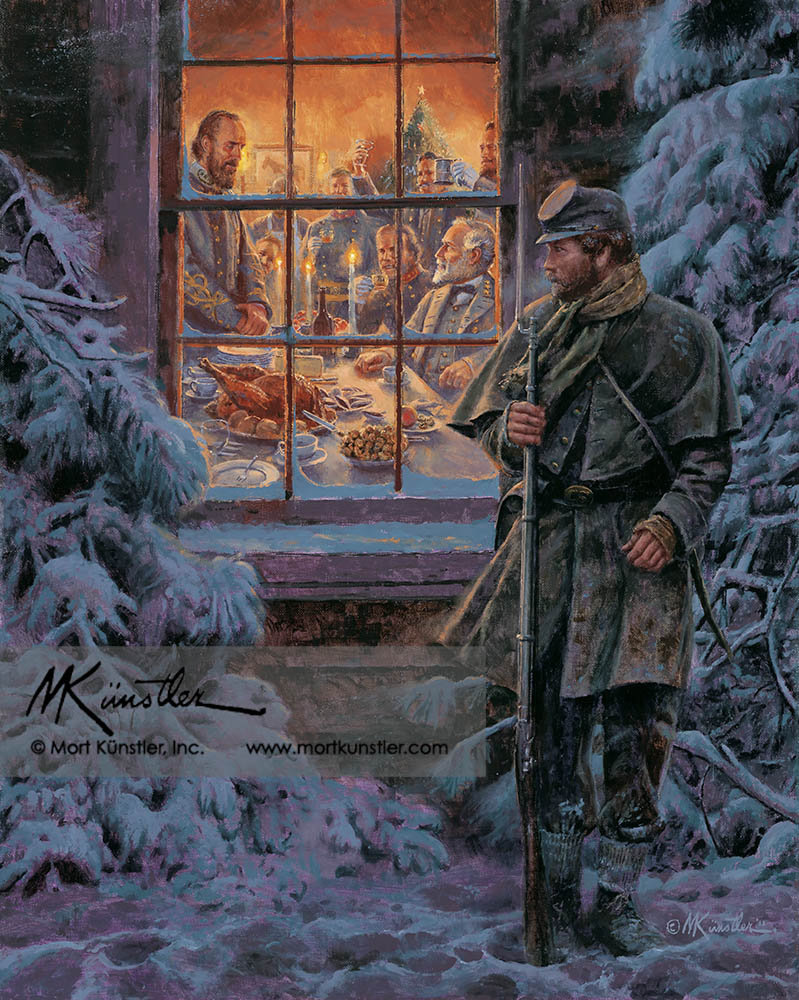The Official Mort Künstler Website
“How Real Soldiers Live…” – limited edition prints
“How Real Soldiers Live…” – limited edition prints
Couldn't load pickup availability
The Premier and Collector’s editions are shipped FREE* and UNSTRETCHED. Stretching is available at an additional charge. Please contact us for pricing: 800-850-1776 or info@mortkunstler.com.
* Free shipping within the Continental United States.
Custom framing is available for this print. Please call 800-850-1776 or email info@mortkunstler.com for more information.
The Official 2011 Snow Print
LIMITED EDITION PRINTS
Paper Prints
Reproduction technique: Fine offset lithography on neutral pH archival quality paper using the finest fade-resistant inks.
Each print is numbered and signed by the artist and accompanied by a Certificate of Authenticity.
Image Size: 27” x 21½” • Overall Size: 32” x 25½”
Signed & Numbered • Edition Size: 350
Signed Artist’s Proof • Edition Size: 50
Giclée Canvas Prints
Reproduction technique: Giclées are printed with the finest archival pigmented inks on canvas.
Each print is numbered and signed by the artist and accompanied by a Certificate of Authenticity.
Signature Edition 21” x 17”
Signed & Numbered • Edition Size: 50
Signed Artist’s Proof • Edition Size: 10
Classic Edition 26” x 21”
Signed & Numbered • Edition Size: 50
Signed Artist’s Proof • Edition Size: 10
Premier Edition 35” x 28”
Signed & Numbered • Edition Size: 15
Signed Artist’s Proof • Edition Size: 5
Historical Information
In December of 1862, Robert E. Lee’s Army of Northern Virginia bedded down for winter quarters in and around the town of Fredericksburg and Spotsylvania County. After defeating their Federal adversaries in one of the most lopsided victories of the entire Civil War, the victorious but weathered army looked to the Christmas season as a welcome reprieve. Celebrations around the campsite were especially joyous during this time, as the daily stress of combat was put aside in favor of high spirits.
Upon his arrival, General Lee was treated to a traditional holiday meal, as well as the welcome company of his most trusted subordinates. The evening went well as conversational merriment replaced the usual discussions of tactics and attrition. Laughter filled the room and, for a few brief hours, the war in Virginia was but a distant memory. For this Christmas night, it was a group of Southern gentlemen, not seasoned soldiers, who came together to celebrate and share a taste of home.
Mort Künstler’s Comments
This painting can be considered a prequel to my painting “Merry Christmas, General Lee,” in which General Robert E. Lee is riding away from the famous Corbin family estate of Moss Neck. On Christmas night, as guests arrived for a party at the mansion, Lee was leaving the small office building of the grand estate where he had attended a Christmas dinner at the invitation of Stonewall Jackson.
I always wanted to do a painting of that dinner, but could not bear to do a totally indoor scene for my annual winter snow print. After years of trying to come up with a composition that would say “snow” and Christmas dinner, I finally composed this painting. It was inspired by the single paragraph in Douglas Southall Freeman’s monumental biography of Robert E. Lee that stated:
“For his own dinner he went by invitation to Jackson’s headquarters, where the doughty ‘Stonewall’ entertained him, Pendleton, and their staffs. Jackson had received many presents of food from admirers and was able to spread a sumptuous table, not forgetting to have his waiters in white aprons. This fastidious touch, in such a setting, appealed to Lee’s sense of humor. He had much jest at the lavishness of Jackson’s entourage. Jackson and his lieutenants, he said, were playing at soldier. They must come and dine with him to see how real soldiers lived. His great lieutenant, of course, was both pleased and confused at Lee’s comments.”
My idea was to capture the viewer in an emotional moment. I decided to contrast the cold loneliness of the sentry peering in the window, to the warm convivial atmosphere of the party going on inside. I also used a cool color palette for the outside of the building and, quite naturally, the warm colors at the opposite end of the spectrum for the interior scene. Making the sentry large emphasized the story of the different circumstances of the officers and the sentry. I tried to depict the private as perhaps envious, but in awe of getting this close private view of the two great Confederate generals. It also gave me an opportunity to show them as smiling and very human. In my quest for a new and different look, I also decided on a vertical composition.
Dr. James I. Robertson, the famed biographer of Jackson wrote in his great biography, “The appearance of wine on Jackson’s table evoked a playful burst of feigned disgrace…even Lee laughed boisterously. Jackson’s slight smile hardly masked his discomfort.” Both Jackson and Lee were teetotalers, and rarely did either one ever enjoy the comforts of anything more than a tent for their headquarters. Placing them both in this comfortable setting reinforces the notion that the holiday season truly was an opportunity to escape the pains of war, if even for a single night.





